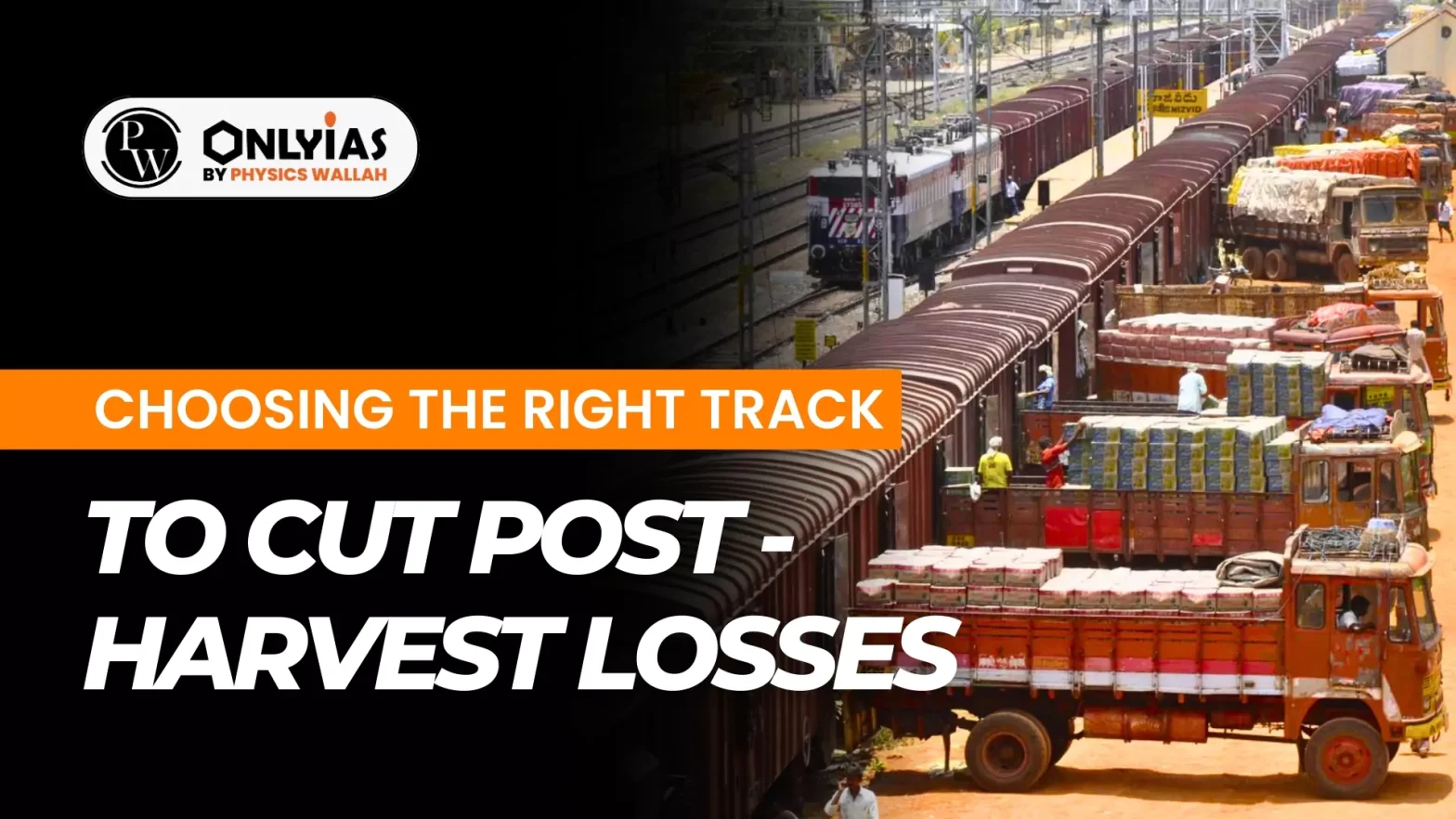India ranks second in global agriculture production, but its share in global agricultural exports is only 2.4%, placing it eighth in the world.
Choosing The Right Track To Cut Post-Harvest Losses
- This is attributed to several factors that include low productivity, an inability to meet desired quality standards and inefficiencies in the supply chain such as an inadequate transportation network and infrastructure, which also leads to significant post-harvest losses.
- India’s post-harvest losses amount to approximately ₹1,52,790 crore annually, according to a Ministry of Food Processing Industries 2022 study.
- As India’s population continues to grow, the challenge of meeting the food and nutrition demand of its people will continue to intensify.
- While growing more food is part of the solution, the prevention of post-harvest losses is crucial.
Enroll now for UPSC Online Course
Post-Harvest Losses
- Post-harvest losses, in simple terms, refer to the amount of food that is lost or wasted after the crop has been harvested but before it reaches the consumer.
- These losses occur during various stages:
- Handling: When crops are damaged during picking, sorting, or packing.
- Storage: When food spoils or is eaten by pests in warehouses or silos.
- Transportation: When produce is damaged or spoils while being moved from farms to markets.
- Processing: When edible parts are discarded during activities like milling or canning.
- Distribution: When food spoils or is damaged in shops, supermarkets, or other points
Perishable Commodity
- A perishable commodity is any product that can spoil, decay, or become unsafe to consume if not stored properly or used within a short time.
- These items have a limited shelf life and typically need refrigeration or special handling to stay fresh.
- Examples Include:
-
- Fresh fruits and vegetables
- Dairy products
- Meat and fish
- Eggs
- Cut flowers.
A Closer Look At India’s Post-Harvest Loss
- The biggest loss is from perishable commodities, which include livestock produce such as eggs, fish and meat (22%), fruits (19%) and vegetables (18%).
- During the export of perishables, approximately 19% of food is lost, particularly at the importcountry (trade partner) stage.
- Storage, transportation and marketing play a critical role in ensuring that perishable products reach the consumer in time.
- The strengthening of agri-logistics is recognisedas a priority by the Committee on Doubling Farmer’s Income (DFI).
- There are multiple logistical requirements in a single supply chain.
- Starting with first mile transport from farmgate to mandi (wholesale/retail), long haul or wholesale transportation by rail, road, water or air, and last mile transportation to the consumer.
- The trade of perishables faces a time shortage once the crop is harvested.
- The latest agriculture Census shows that 86% of farmers in India are small and marginal (SMF).
- They struggle to attain economy of scale due to the small production.
- Together with a lack of assured market connectivity, this results in post-harvest losses, which includes income losses for the farmers.
- In India, food price volatility has been caused partly by supply constraints affecting perishable produce.
- As in a NITI Aayog report, the revenue of the Indian Railways is primarily driven by freight transport, which includes commodities such as iron, steel, fertilizers and agricultural produce.
- In the 2022 fiscal year, it accounted for 75% of its total earnings.
- The Indian Railways efficiently connects urban centres and rural areas across the country.
- The Food Corporation of India is heavily dependent on the Indian Railways to move approximately 90% of its food grains.
- In contrast, about 97% of fruits and vegetables are transported by road.
Check Out UPSC NCERT Textbooks From PW Store
Initiatives by the Railways
- The Indian Railways has taken a few initiatives to improve its freight operations in perishables.
- The truck-on-train service carries loaded trucks on railway wagons.
- Efforts are being made to expand this service following successful trial runs involving commodities such as milk and cattle feed.
- During the COVID-19 pandemic, the Railways introduced parcel special trains to transport perishables and seeds between market and producers.
- Additionally, to support SMFs, the Kisan Rail was initiated to connect perishables (inclusive of milk, meat and fish) production surplus regions to consumption regions more efficiently.
- A recent study highlighted the impact of the Kisan Rail scheme on reducing post-harvest losses and enhancing farmer incomes in India.
- For example, grape growers in Nashik, Maharashtra, secured a net profit of ₹5,000 per quintal by supplying about 22,000 quintals using Kisan Rail.
- This highlights the advantage of using rail-based long-haul of fruits and vegetables.
- In recent times, the role of the Railways in the agricultural sector has shown promising results.
- However, initiatives must also focus on increasing awareness and accessibility of farmers to available Railway schemes.
- Friends of Champions 12.3 India, a coalition of food supply chain actors powered by WRI India, also identified that multiple touch points during the transport of perishables using the Railways is a challenge.
- Therefore, investment in specialised wagons for temperature-controlled transport and the establishment of rail-side facilities for safe cargo handling are essential.
- This would also present a significant opportunity to enhance food safety in the agriculture sector, by minimising spoilage and contamination risks, thereby supporting both domestic and export markets.
- Further, the DFI committee recommends streamlining loading and unloading processes to minimise transit times.
- It also emphasises addressing staffing shortages through recruitment and training initiatives. Prioritising the Railways over roadways, particularly for fruit and vegetable transportation, promises efficient transportation.
Untapped Opportunities
- The Railways offers a tremendous opportunity to reduce post-harvest losses and positively impact not just livelihoods but also the environment.
- Findings from the Logistics Division, Ministry of Commerce, state that the Indian Railways generates up to 80% less carbon dioxide for freight traffic than road transport.
- There is a need for adopting systems-based approach, cutting across modes of transport and geographies.
- The private sector can play a crucial role in enhancing operational efficiency and strengthening the rail infrastructure through public-private partnerships.
- The budgetary allocation for agriculture 2024 also aims to bridge the farm-to-market gap with modern infrastructure and value-addition support.
- Such Railway initiatives complement these efforts by supporting the efficient transportation of perishable goods and minimising post-harvest losses.
Enroll now for UPSC Online Classes
Conclusion
Reducing post-harvest losses in India through improved rail logistics and infrastructure is crucial for enhancing food security, farmer incomes, and environmental sustainability.
![]() 18 Jul 2024
18 Jul 2024

